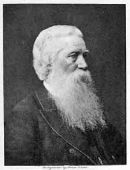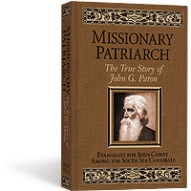MP3: A Life Well Spent: John G. Paton
January 28, 2008 2 Comments
MP3 and Transcript of Piper’s Biographical Sketch: You Will be Eaten by Cannibals! Lessons from the Life of John G. Paton: Courage in the Cause of Missions
A Brief Biography:
John G. Paton entered the world as the firstborn son (of eleven children) to James and Janet Paton on May 24, 1824. His father was a very devout and godly man, and it was perhaps his influence that God used most in John Paton’s life. His parents faithfully prayed for John to serve God through foreign missions, but did not inform him of their prayer till John made this public. Prior to his service on a foreign field, he spent several years in training and then ministered tirelessly amongst the poor and despised as what we would today call an “urban missionary.”
It was not until April 16, 1858 that he set sail for the New Hebrides along with his new bride of 14 days, Mary Ann (Robson). They went knowing that they were taking the Gospel to cannibals. In fact, when he received counsel not to go because of this, he responded:
Mr. Dickson, you are advanced in years now, and your own prospect is soon to be laid in the grave, there to be eaten by worms; I confess to you, that if I can but live and die serving and honoring the Lord Jesus, it will make no difference to me whether I am eaten by Cannibals or by worms; and in the Great Day my Resurrection body will rise as fair as yours in the likeness of our risen Redeemer.
And although Paton was not eaten by cannibals upon his arrival, he faced many continuous trials until the time he left the island of Tanna. Less than a year after their first anniversary, Mary Ann died of tropical fever, and just over 2 weeks later their 36 day old son died.
He eventually did have to leave Tanna and returned to Scotland for a brief time, at which time he married Maggie (Whitecross). They returned to the New Hebrides, this time to the island of Aniwa. It was there that God brought forth much fruit, and by 1899—33 years after their arrival on the island—they had seen the New Testament printed and missionaries were preaching the Gospel on over 80 percent of the islands of the New Hebrides. Neither he nor Maggie were eaten by cannibals, but entered into the presence of the Lord by natural deaths in 1907 and 1905, respectively. Truly, by his own description, his was a “life well spent.”
Recommended Reading:
Daniel and I have both enjoyed reading Paton’s autobiography, Missionary Patriach: The True Story of John G. Paton, published by The Vision Forum. (This was actually a graduation gift to me from Daniel’s parents! :))
Incidentally, I also received Maggie Paton’s Letters and Sketches as a gift from both Daniel and his parents before we were married. (Guess which I ended up keeping? 🙂)
Both of these books are also available to read online (free!) with Google Books:
John G. Paton, D.D., Missionary to the New Hebrides: An Autobiography




Recent Comments